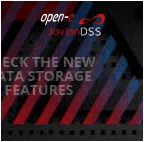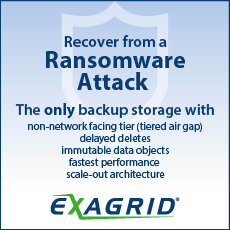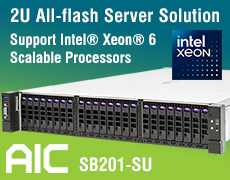Broadcom Licensing Changes for VMware vSAN 8
Prompting reevaluation of HA solutions for SMB and edge locations
This is a Press Release edited by StorageNewsletter.com on June 25, 2024 at 2:02 pm This report, dated June 6, 2024, was written by Jerome M. Wendt, president and founder, Data Center Intelligence Group LLC (DCIG).
This report, dated June 6, 2024, was written by Jerome M. Wendt, president and founder, Data Center Intelligence Group LLC (DCIG).
Broadcom Licensing Changes for VMware vSAN 8
Prompting reevaluation of HA solutions for SMB and edge locations
In 2019 DCIG first examined how well StorMagic SvSAN and VMware vSAN align with organizational needs to operate 24×7. This initial report considered how well each of these 2 solutions fit in SMBs and edge locations.
Since then, the operational reality in SMBs and edge locations has changed little. If anything, these size organizations increasingly need cost-effective, reliable highly available (HA) solutions to host their applications and data.
However, significant changes within StorMagic SvSAN 6.3 and VMware vSAN 8 have occurred during this same time. Both solutions have made notable improvements to their technical features. However, VMware has significantly changed its vSAN software licensing costs. These new, higher costs largely surfaced after Broadcom completed its acquisition of VMware in November 2023.
These technical changes, coupled with VMware vSAN 8’s price increases, have prompted many VMware customers to reconsider competitive solutions. StorMagic SvSAN 6.3 has emerged as a top alternative to vSAN 8 for SMB and edge locations.
As organizations consider these two solutions, distinct differences between them exist in at least four areas.
These differences include the following:
- Software options and associated licensing costs
- Minimum server hardware requirements.
- Two-node HA cluster configuration.
- Management.
SMB and edge sites have specific HCI requirements
These remote environments can differ significantly from enterprises in their requirements. They resemble enterprises in their desire for solutions with cloud-like infrastructures, centralized management, and HA. However, they often lack on-site IT personnel, have limited budgets, possess no formal data center, and may have only limited WAN connectivity.
These size environments and organizations then face a tough choice. Do they try to make a solution such as VMware vSAN 8 work for them? Or do they pursue a solution such as SvSAN that StorMagic purpose builds to address the specific needs of SMB and edge locations?
Four VMware VSAN 8/StorMagic SVSAN 6.3 differentiators for MB and edge sites
The recent DCIG Competitive Intelligence report provides 4 comparisons to help organizations evaluate these 2 solutions. It explains how VMware vSAN 8 and StorMagic SvSAN 6.3 differ in key areas that matter to SMB and edge sites.
Here is a summary of their 4 differences:
Differentiator 1: Software options and associated licensing costs
Since VMware’s acquisition by Broadcom, VMware software licensing has become a point of emphasis. Broadcom has changed both how it licenses VMware software and the prices it charges. These changes have significantly impacted vSAN 8’s costs.
For instance, organizations may no longer obtain vSAN 8 as a standalone product. They may only obtain it as an add-on after first licensing VMware Cloud Foundation (VCF) or VMware vSphere Foundation (VVF). They may also only run the VMware vSphere hypervisor when using vSAN 8 in this configuration.
In contrast, StorMagic does not tie hypervisor licensing to SvSAN 6.3’s software licensing. Rather, organizations may license and use any or all three hypervisors supported by SvSAN. Its supported hypervisors include Linux KVM, Microsoft Hyper-V, and VMware vSphere. They may even use SvSAN 6.3 in conjunction with VCF or VVF.
Differentiator 2: Minimum server hardware requirements
Both SvSAN 6.3 and vSAN 8 continue to capitalize on the significant advancements in baseline server hardware capacity and performance. Further, these advancements in server hardware components often come with nominal price increases. Almost any server that an organization deploys often includes robust CPUs and significant memory and storage capacity.
Many servers now ship with SSDs) in lieu of HDDs. Both HDDs and SSDs offer high amounts of storage capacity. However, SSDs offer higher levels of performance and lower failure rates at approximately the same price as HDDs.
VMware vSAN 8, available as an add-on to VCF or VVF, manages NVMe SSDs with its Express Storage Architecture (ESA). VMware specifically designed the vSAN 8 ESA to capitalize on the availability and features of NVMe SSDs in modern server hardware. However, capitalizing on these vSAN 8 ESA features necessitates that organizations deploy more robust server hardware. Each server running vSAN 8 must minimally contain 2 SSDs to create a RAID-1 configuration in each one.
Organizations may still choose to use VMware’s pre-existing vSAN 8 Original Storage Architecture (OSA). To use vSAN 8 OSA organizations must still use a server that possesses at least 2 drives. One must be an SSD drive for processing and the other either an HDD or SSD for storage capacity.
In contrast, StorMagic SvSAN 6.3 gives SMB and edge environments more options to utilize servers with lower baseline hardware configurations. Due to SvSAN’s lower, minimum server hardware requirements, organizations may find many existing and new server models meet these specifications. As such, the hypervisor’s minimum hardware requirements will likely drive the server hardware decision.
StorMagic SvSAN also supports any provider’s server hardware that meets its minimum hardware specs. This minimizes the need for organizations to acquire specific vendor-approved hardware or go through a complicated certification process.
Differentiator 3: Two-node HA cluster configuration
Cost-effectively delivering HA in SMB and edge locations often requires the use of a witness host. Both VMware vSAN 8 and StorMagic SvSAN employ this technique. However, each one employs different techniques to deploy its witness host. This impacts both the ease of management and the cost of the solution.
The 2 different storage architectures in vSAN 8 (OSA and ESA) currently each require their own dedicated Witness Host.
These configurations work (at a high level) as follows:
- Each 2-node vSAN 8 OSA cluster requires a Witness Host dedicated to servicing OSA clusters.
- Each 2-node vSAN 8 ESA cluster requires a Witness Host dedicated to servicing ESA clusters.
- Deploying both vSAN 8 OSA and ESA clusters requires a separate, dedicated Witness Host to service each cluster type.
- An organization must also appropriately size the witness appliance that services each vSAN 8 cluster type
StorMagic SvSAN, on the other hand, offers 2 configuration options for organizations: local or remote deployment of the SvSAN witness software, or witness-as-a-service (WaaS) subscription. Each witness supports up to 1,000 SvSAN clusters and requires 9Kb/s of bandwidth per mirrored volume.
SvSAN’s lower bandwidth requirements and higher latency tolerances create new possibili≠ties for organizations to deploy HA. They may build HA configurations in many remote sites around the world. They may even deploy clusters that span two campus or metropolitan sites as SvSAN 6.3 supports stretched clusters as a feature.
Differentiator 4: Management options
Centrally managing solutions deployed across SMB and remote sites becomes key to keeping them running efficiently and effectively.
VMware’s requirement to license either VCF or VVF before an organization can obtain and use vSAN 8 includes a management benefit. The VCF and VVG licensing each includes VMware’s management software: vSphere Enterprise Plus and vCenter Server Standard. Using this management software, an organization may centrally manage and maintain both VMware vSphere and vSAN 8.
StorMagic offers organizations multiple options for management at the edge. Since SvSAN supports 3 different hypervisors, organizations may use any management tools available from each hypervisor. The company also provides its StorMagic Edge Control providing centralized control and management of its underlying SvSAN solution.
The 12-page DCIG Competitive Report contains the many in-depth technical details that organization need to better compare VMware vSAN 8 and StorMagic SvSAN 6.3 for their SMB or edge environment.
It also provides the following tables that compare:
- VMware vSAN 8’s and StorMagic SvSAN 6.3’s minimum MSRP software licensing costs
- The minimum server hardware requirements for each solution.
- How their respective witness host offering deliver HA and their technical requirements.













 Subscribe to our free daily newsletter
Subscribe to our free daily newsletter

